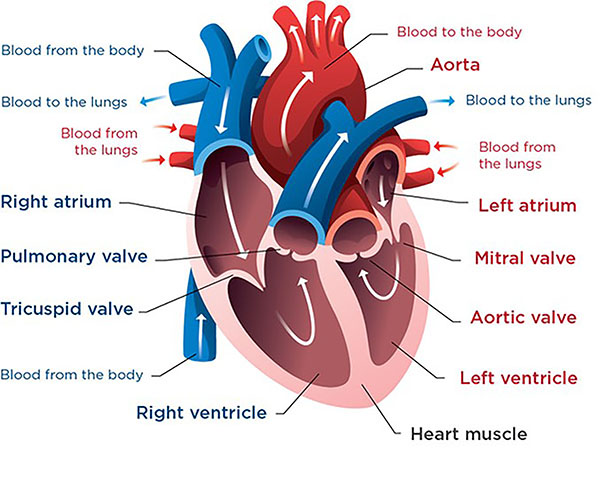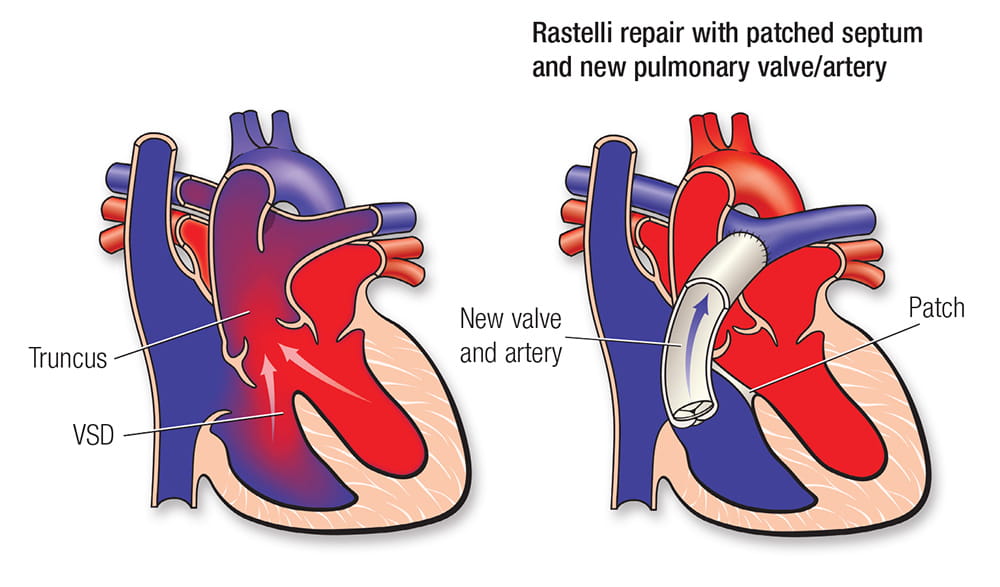Truncus Arteriosus
What is truncus arteriosus?
 This is a normal heart. It sends oxygen-rich blood to the body through the aorta and oxygen-poor blood to the lungs through the pulmonary artery. In truncus arteriosus, the aorta and pulmonary artery are joined. There’s a hole in the wall between the left and right ventricles, letting oxygen-rich and oxygen-poor blood mix in the heart.
This is a normal heart. It sends oxygen-rich blood to the body through the aorta and oxygen-poor blood to the lungs through the pulmonary artery. In truncus arteriosus, the aorta and pulmonary artery are joined. There’s a hole in the wall between the left and right ventricles, letting oxygen-rich and oxygen-poor blood mix in the heart.Truncus arteriosus (pronounced TRUN-kus ar-teer-ee-OH-sus) is a birth defect in which only 1 large artery leaves the heart.
Normally, 2 large arteries leave the heart — the aorta, which carries oxygen-rich (red) blood from the left ventricle to the body, and the pulmonary artery, which carries oxygen-poor (blue) blood from the right ventricle to the lungs.
In babies with this condition, the aorta and pulmonary artery are joined. They form a large common artery, called the truncus arteriosus, or trunk. The arteries to the lungs (pulmonary arteries) branch off from this trunk.
There are 4 types of truncus arteriosus (types I, II, III and IV). The type depends on where the pulmonary arteries are and whether they formed as a single artery or several arteries.
-
How does truncus arteriosus affect my child?
Babies with truncus arteriosus also have a hole in the wall between their left and right ventricles. This hole is known as a ventricular septal defect. The hole allows oxygen-rich blood from the left ventricle to mix with oxygen-poor blood from the right ventricle.
The mixed blood enters the trunk and goes out to both the body and the lungs. Some of the blood going out to their body does not have oxygen. This explains why a baby with this condition may have blue or purple-tinged skin, lips or nail beds (cyanosis). Truncus arteriosus is a type of cyanotic heart disease.
Truncus arteriosus may cause your baby’s lungs to get too much blood. This makes it hard to breathe and can lead to high blood pressure in the lungs and heart failure.
Heart Center at Seattle Children's
Symptoms of Truncus Arteriosus
Babies with truncus arteriosus may have these symptoms:
- Blue or purple-tinged skin, lips, mouth or nail beds (cyanosis)
- Fast breathing
- Working hard to breathe
- Trouble feeding
- Delayed growth or failure to thrive
- Getting more tired than normal
- Thicker, broader fingertips (clubbing)
They may also develop symptoms of heart failure.
Diagnosing Truncus Arteriosus
Sometimes doctors can diagnose this condition in a developing baby before birth. They might first see something different about your baby’s heart on standard prenatal ultrasound. To learn more about your baby’s heart, you might have a fetal echocardiogram (an ultrasound done to check the heart more closely). Seattle Children’s Fetal Care and Treatment Center team can care for you when you are pregnant if your developing baby has a known or suspected problem.
To diagnose this condition after birth, your baby’s doctor will examine your baby and use a stethoscope to listen to their heart. In babies with this condition, doctors can often hear a heart murmur.
The doctor will ask for details about any symptoms your baby has, their health history and your family health history.
Your baby will need tests that provide more information about how their heart and nearby blood vessels look and work. These may include:
- Electrocardiogram
- Chest X-ray
- MRI (magnetic resonance imaging)
- Echocardiography
- Cardiac catheterization
Treating Truncus Arteriosus
Babies with truncus arteriosus need surgery early in life so their body gets only oxygen-rich blood.
If your baby has symptoms of heart failure, they may need medicines to help their heart work better until they have surgery.
Before surgery to fix truncus arteriosus, some babies have surgery to put a band around their pulmonary artery. This narrows the artery so the baby’s lungs do not get too much blood.
 From heart.org. ©2009, American Heart Association, Inc.
From heart.org. ©2009, American Heart Association, Inc.During surgery to fix truncus arteriosus:
- The surgeon detaches your baby’s main pulmonary artery or left and right pulmonary arteries from the large common artery. This leaves only the aorta coming out of your baby’s heart.
- Then the surgeon connects the main pulmonary artery or the left and right pulmonary arteries to your baby’s right ventricle. This may involve putting in a tube, called a conduit, to make the connection. The surgeon may also put in a pulmonary valve.
- Last, the surgeon closes your baby’s ventricular septal defect with a patch. This keeps oxygen-rich blood out of the right ventricle and oxygen-poor blood out of the left ventricle. The patch is placed so that blood flows from the left ventricle into the aorta.
Your baby’s surgeon will consider the type of truncus arteriosus your child has to tell the exact surgery your child needs and when.
After recovering from surgery, it will be important for your child to keep seeing their cardiologist on a regular schedule to check their heart health. The conduit between your child’s pulmonary artery and right ventricle does not grow along with them. So, as your child grows, they will need surgery again to change the conduit. Later in life, some children with truncus arteriosus need their aortic valve replaced because it did not form the way it should. With regular visits, your child’s team can check for early signs of any issues and make sure your child gets the care they need.
Truncus Arteriosus at Seattle Children’s
-
The experts you need are here
- Our team of more than 40 pediatric cardiologists has diagnosed and treated this condition in many babies — and we provide any ongoing care that patients need as they grow into young adults.
- Our pediatric cardiac surgeons perform more than 500 procedures yearly. We have deep experience in correcting truncus arteriosus and treating related heart conditions in babies.
- We also have a Pediatric Cardiac Anesthesia team and a Cardiac Intensive Care Unit ready to care for children who have heart surgery.
-
Among the nation’s top programs
- Our surgical outcomes are among the best in the nation year after year.
-
Care from before birth through young adulthood
- If your developing baby is diagnosed with truncus arteriosus before birth, our Fetal Care and Treatment Center team works closely with you and your family to plan and prepare for the care your baby will need.
- Your child’s treatment plan is custom-made. We plan and perform your child’s surgery based on the specific details of their condition, like their type of truncus arteriosus. We closely check your child’s needs to make sure they get the care that is right for them at every age.
- We have a special Adult Congenital Heart Disease Program to meet your child’s long-term healthcare needs. This program, shared with the University of Washington, transitions your child to adult care when they are ready.
-
Support for your whole family
- We are committed to your child’s overall health and well-being and to helping your child live a full and active life.
- Whatever types of care your child needs, we will help your family through this experience. We will discuss your child’s condition and treatment options in ways you understand and involve you in every decision.
- Our child life specialists know how to help children understand their illnesses and treatments in ways that make sense for their age.
- Seattle Children’s has many resources, from financial to spiritual, to support your child and your family and make the journey as smooth as possible.
- Many children and families travel to Seattle Children’s for heart surgery or other care. We help you coordinate travel and housing so you can stay focused on your child.
- Read more about the supportive care we offer.
Contact Us
Contact the Heart Center at 206-987-2515 for an appointment, second opinion or more information.
Providers, see how to refer a patient.

